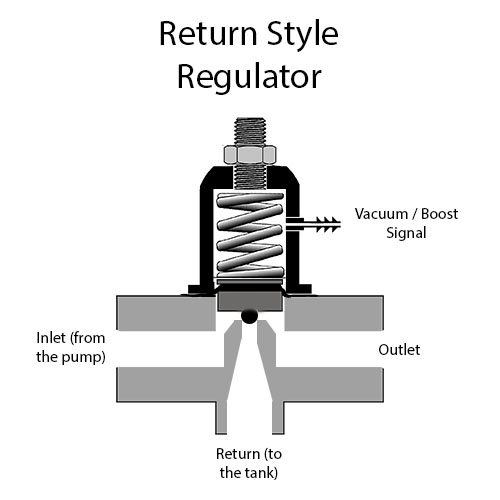How to Unstick a Fuel Pressure Regulator: Step-by-Step Guide
The fuel pressure regulator is a critical component of a vehicle's fuel system, responsible for maintaining the correct fuel pressure for optimal engine performance. However, over time, the fuel pressure regulator may become stuck or clogged, leading to fuel delivery issues. In this step-by-step guide, we will explore how to unstick a fuel pressure regulator effectively, allowing for proper fuel flow and restoring your vehicle's performance.
1. Understanding the Fuel Pressure Regulator

Fuel Pressure Regulator
Before attempting to unstick a fuel pressure regulator, it is essential to understand its function and role in the fuel system. The fuel pressure regulator controls the amount of fuel flowing to the engine by regulating the pressure in the fuel lines. It ensures that the fuel pressure remains within the specified range for efficient combustion.
2. Identifying Symptoms of a Stuck Fuel Pressure Regulator
A stuck fuel pressure regulator can cause various symptoms, indicating a potential issue. These symptoms may include:
Difficulty starting the engine or engine hesitation.
Rough idling or stalling.
Decreased fuel efficiency.
Fuel odor.
Black smoke from the exhaust.
Engine misfires.
Fuel leaks around the regulator.
If you notice any of these symptoms, it is crucial to address the issue promptly.
3. Safety Precautions
Before working on the fuel pressure regulator, it is important to take the necessary safety precautions:
Ensure that the engine is completely cool before starting any work.
Park the vehicle in a well-ventilated area, away from open flames or sparks.
Disconnect the negative terminal of the vehicle's battery to prevent accidental electrical sparks.
Wear protective gloves and safety glasses to protect yourself from fuel spills and potential hazards.
4. Locating the Fuel Pressure Regulator

Fuel Pressure Regulator
The fuel pressure regulator is typically located on or near the fuel rail or fuel line. Consult your vehicle's owner's manual or refer to online resources to locate the specific location of the fuel pressure regulator in your vehicle.
5. Depressurizing the Fuel System
Before un-sticking the fuel pressure regulator, it is crucial to relieve the fuel system's pressure to avoid fuel spray or leaks. Follow these steps to depressurize the fuel system:
Locate the fuel pump relay or fuse in the vehicle's fuse box.
Remove the fuel pump relay or fuse to disable the fuel pump.
Start the engine and allow it to run until it stalls or until the fuel pressure is relieved.
Once the engine stalls, turn off the ignition and reinsert the fuel pump relay or fuse.
6. Removing and Inspecting the Fuel Pressure Regulator
To unstick the fuel pressure regulator, follow these steps:
Disconnect the fuel line(s) connected to the fuel pressure regulator using a line wrench or appropriate tool.
Remove any retaining clips or screws that secure the regulator to the fuel rail or fuel line.
Carefully detach the fuel pressure regulator from its mounting location.
Inspect the regulator for any signs of damage or contamination, such as debris or clogging. If necessary, clean or replace the regulator.
7. Cleaning or Lubricating the Fuel Pressure Regulator
If the fuel pressure regulator appears stuck or sticky, you can try cleaning or lubricating it to restore proper functionality. Use the following methods:
Cleaning: Use a suitable fuel system cleaner or solvent to remove any dirt or debris that may be causing the sticking. Follow the manufacturer's instructions for the specific cleaner you are using. Use a clean cloth or brush to scrub away any deposits carefully.
Lubricating: Apply a small amount of fuel system lubricant or silicone lubricant to the moving parts of the fuel pressure regulator. This can help reduce friction and prevent sticking in the future. Be cautious not to use excessive lubricant that could contaminate the fuel system.
8. Reinstalling the Fuel Pressure Regulator
After cleaning or lubricating the fuel pressure regulator, follow these steps to reinstall it:
Place the regulator back in its mounting location on the fuel rail or fuel line.
Secure the regulator with any retaining clips or screws that were removed earlier.
Reconnect the fuel line(s) to the fuel pressure regulator, ensuring they are properly tightened using a line wrench or appropriate tool.
Double-check all connections for tightness and proper alignment.
9. Testing and Verifying
After reinstalling the fuel pressure regulator, it is crucial to test its functionality and verify that the fuel system operates correctly. Follow these steps:
Reconnect the negative terminal of the vehicle's battery.
Turn the ignition key to the "ON" position without starting the engine. This will prime the fuel system.
Inspect the fuel system for any leaks or abnormalities.
Start the engine and observe its performance. Ensure that the symptoms previously experienced have been resolved.
Unsticking a fuel pressure regulator is a necessary step in maintaining a properly functioning fuel system. By following this step-by-step guide, you can safely and effectively unstick the fuel pressure regulator, restoring proper fuel flow and improving your vehicle's performance. Remember to exercise caution, follow safety precautions, and consult professional assistance if needed. A properly functioning fuel pressure regulator ensures optimal fuel delivery and contributes to the smooth operation of your vehicle's engine.